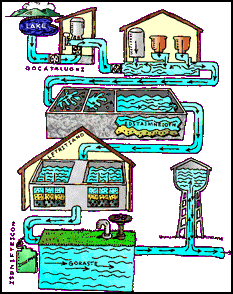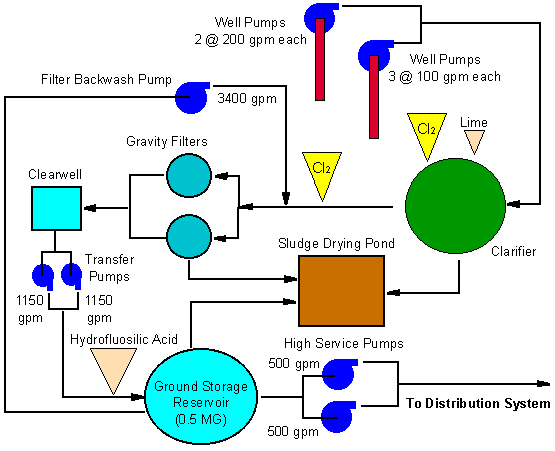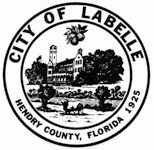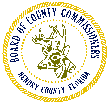The City of LaBelle
Department of Public Works

WATER TREATMENT PLANT
The
City of LaBelle water
treatment plant is designed to serve under 10,000 people. It is a typical system
and includes the following components:
 |
 |
 |
 |
Ground water well #10 (8 inch
diameter) pumps water from a surficial aquifer 45 feet below the ground at a rate of 200
gallons per minute. |
Storage cylinders
(p455) contain the chlorine gas that serves as the disinfectant. |
Addition of chlorine
also oxidizes
dissolved iron in the water into a solid form that can be removed by the filter. (p453) |
Chlorine gas is metered into
the treated water at various points of the process to remove biological hazards and
minerals. (p458) |
 |
 |
 |
 |
Handling tanks mixes hydrated lime for addition
as a chemical
treatment of the ground water (p457). |
The lime powder is metered into the mixing tank for
injection to the clarifier (p456). |
The lime slurry is added at
the center of the clarifier where it mixes with the raw ground water (p448). |
Lime softening
removes hardness by reacting it with lime (calcium hydroxide) creating calcium
carbonate (p460) . |
 |
 |
 |
 |
The clarifier acts as a settling basin
allowing the solid precipitate to flocculate into large
particles and create a sludge (p459). |
After rising from the bottom
of the clarifier the water collects in a
ring channel and flows by gravity to the gravity filters (p449). |
The sludge at the bottom of the clarifier is
scraped and pumped to a chamber connected to sludge drying pond (p452). |
The sludge pumped into a shallow pond area
where the solid materials settle out and stored for later collection (p462). |
 |
 |
 |
 |
The clarifier unit is
adjacent to the building housing the gravity filters and pump room (p454). |
Water from the clarifier
enters the rapid
sand filters (p450) which remove the remaining small particles from the water |
The pump room (p446) moves water from the sand
filters to the clear well then to the storage tank. |
The treated water is stored in an above-ground
tank (p461) prior to final chlorination and pumping into the distribution pipes to homes
& businesses. |
The figure below provides a more detailed schematic
of the Port LaBelle Utilities System water treatment plant.

MEASUREMENTS OF
TRIHALOMETHANE IN DRINKING WATER
The water
supplies of many small communities are affected by a continuing national effort to improve
the quality of our
drinking water. Results of water quality monitoring in the Port LaBelle
Utilities System show concentrations in excess of the 0.10 mg/L federal limit for total
trihalomethanes (TTHM) levels.
| 03-11-98 |
06-05-98 |
08-27-98 |
Water Sample
Location |
Chlorine
Residual |
TTHM |
Water Sample
Location |
Chlorine
Residual |
TTHM |
Water Sample
Location |
Chlorine
Residual |
TTHM |
| mg/L |
mg/L |
mg/L |
mg/L |
mg/L |
mg/L |
| 1020 Park Drive |
1.0 |
0.156 |
904 Greentree South |
0.2 |
0.297 |
904 Greentree South |
0.3 |
0.133 |
| 480 Forestry Drive |
0.7 |
0.177 |
661 Seminole |
2.3 |
0.180 |
510 Davis Street |
0.2 |
0.158 |
| 865 Ft. Thompson St |
0.7 |
0.135 |
865 Ft. Thompson St |
0.8 |
0.280 |
865 Ft. Thompson St |
0.3 |
0.140 |
| 930 Highway 80 |
1.2 |
0.166 |
900 Highway 80 |
0.3 |
0.231 |
900 Porterfield |
0.3 |
0.146 |
These high TTHM levels will be eliminated when the the water treatment
plant installs a new chloramine system in June, 1999. This modification to the water
treatment system has been designed and planned by Applied Technology and Management.
Detailed information about trihalomethanes
in drinking water is available from Southern DataStream in LaBelle, Florida.
Back to the
City of LaBelle Page  and
Hendry County Page
and
Hendry County Page

Back to

Page originally produced on Dec. 29, 1998


















 and
Hendry County Page
and
Hendry County Page

